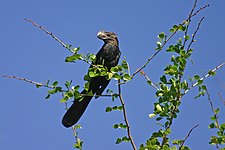Smooth-billed ani
The smooth-billed ani (Crotophaga ani) is a large near passerine bird in the cuckoo family. It is a resident breeding species from southern Florida, the Caribbean, parts of Central America, south to western Ecuador, Brazil, northern Argentina and southern Chile[2]. It was introduced to Galápagos around the 1960s and is potentially impacting native and endemic species across the archipelago.[3]
| Smooth-billed ani | |
|---|---|
| in Grand Cayman | |
| Scientific classification | |
| Kingdom: | Animalia |
| Phylum: | Chordata |
| Class: | Aves |
| Order: | Cuculiformes |
| Family: | Cuculidae |
| Genus: | Crotophaga |
| Species: | C. ani |
| Binomial name | |
| Crotophaga ani | |
 | |
Description
The smooth-billed ani is a mid-sized species, larger on average than the groove-billed ani but smaller than the greater ani. It measures 30–36 cm (12–14 in) in length and weighs 71–133 g (2.5–4.7 oz).[4][5] The adult is mainly flat black, with a long tail, deep ridged black bill and a brown iris. The flight is weak and wobbly, but the bird runs well and usually feeds on the ground. This species is called "el pijul" in Venezuelan folklore. It is mentioned in the popular Veracruz song "El Pijul".
Habitat
This ani is found in open and semi-open country and areas under cultivation. The nest, built communally by several pairs, is a deep cup lined with leaves and placed usually 2–6 m (6.6–19.7 ft) high in a tree. A number of females lay their chalky blue eggs in the nest and then share incubation and feeding. This common and conspicuous species has greatly benefited from deforestation.
Breeding
Each female is capable of laying up to seven eggs, and nests have been found containing up to 29 eggs, but it is rare for more than ten to hatch. Incubation is 13–15 days, with another 10 days to fledging. Up to three broods may be raised in a season, with the young of earlier broods helping to feed more recent chicks.
Diet and calls
This is a very gregarious species, always found in noisy groups. The calls include a whining ooo-leeek. The smooth-billed ani feeds on termites, large insects and even lizards and frogs. They will occasionally remove ticks and other parasites from grazing animals.
- Egg, Collection Museum Wiesbaden
_To.jpg) in Tobago
in Tobago.jpg) in Jamaica
in Jamaica in Dominica
in Dominica in Colombia
in Colombia
References
- BirdLife International (2012). "Crotophaga ani". IUCN Red List of Threatened Species. 2012. Retrieved 26 November 2013.CS1 maint: ref=harv (link)
- "Maracaballos de pico liso - AVES DE CHILE". www.avesdechile.cl. Retrieved 2020-08-17.
- Cooke, Sophia C.; Haskell, Lucy E.; van Rees, Charles B.; Fessl, Birgit (January 2019). "A review of the introduced smooth-billed ani Crotophaga ani in Galápagos". Biological Conservation. 229: 38–49. doi:10.1016/j.biocon.2018.11.005.
- "Smooth-billed ani". All About Birds. Cornell Lab of Ornithology.
- Dunning Jr., John B., ed. (1992). CRC Handbook of Avian Body Masses. CRC Press. ISBN 978-0-8493-4258-5.
- Hilty, Steven L. (2003). Birds of Venezuela. Princeton University Press. ISBN 0-7136-6418-5.
- ffrench, Richard; O'Neill, John Patton; Eckelberry, Don R. (1991). A Guide to the Birds of Trinidad and Tobago (2nd ed.). Ithaca, N.Y.: Comstock Publishing. ISBN 0-8014-9792-2.
External links
| Wikimedia Commons has media related to Crotophaga ani. |
| Wikispecies has information related to Crotophaga ani |
- Smooth-billed Ani Images at Monte M. Taylor's Photo Gallery
- Pictures, description, maps at www.surinamebirds.nl
- "Crotophaga ani". Integrated Taxonomic Information System.
- "Smooth-billed ani media". Internet Bird Collection.
- Smooth-billed Ani Bird Sound at Florida Museum of Natural History
- BirdLife species factsheet for Crotophaga ani
- Smooth-billed ani photo gallery at VIREO (Drexel University)
- Smooth-billed ani species account at Neotropical Birds (Cornell Lab of Ornithology)
- Interactive range map of Crotophaga ani at IUCN Red List maps
- Audio recordings of Smooth-billed ani on Xeno-canto.
